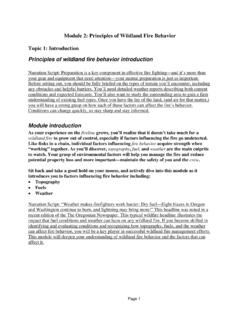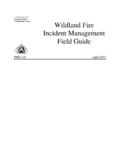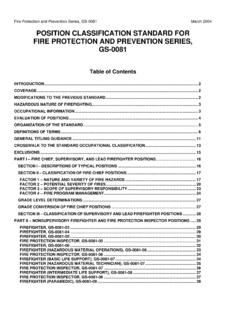Transcription of The Costs and Losses of Wildfires - NIST
1 NIST Special Publication 1215 The Costs and Losses of Wildfires A Literature Review Douglas Thomas David Butry Stanley Gilbert David Webb Juan Fung This publication is available free of charge from: NIST Special Publication 1215 The Costs and Losses of Wildfires A Literature Survey Douglas Thomas David Butry Stanley Gilbert David Webb Juan Fung Applied Economics Office Engineering Laboratory This publication is available free of charge from: November 2017 Department of Commerce Wilbur L. Ross, Jr., Secretary National Institute of Standards and Technology Walter Copan, NIST Director and Under Secretary of Commerce for Standards and Technology Certain commercial entities, equipment, or materials may be identified in this document in order to describe an experimental procedure or concept adequately.
2 Such identification is not intended to imply recommendation or endorsement by the National Institute of Standards and Technology, nor is it intended to imply that the entities, materials, or equipment are necessarily the best available for the purpose. Photo Credit: Lake City, Fla., May 15, 2007 --The Florida Bugaboo Fire still rages out of control in some locations. FEMA Photo by Mark Wolfe -May 14, 2007 -Location: Lake City, FL: National Institute of Standards and Technology Special Publication 1215 Natl. Inst. Stand. Technol. Spec. Publ. 1215, 72 pages (October 2017) CODEN: NSPUE2 This publication is available free of charge from: Abstract This report enumerates all possible Costs of wildfire management and wildfire-related Losses . It, further, compiles estimates or proposes methods for estimating the Costs and Losses identified.
3 These estimates can be used for C+NVC ( cost plus net value change) modeling, and can also be used to produce an estimate of the economic burden of wildfire for the United States. The economic burden represents the impact wildfire has on the economy. Tracking the economic burden of wildfire could be used to assess return-on-investment into wildfire interventions. The economic burden is decomposed into: 1. intervention Costs ; 2. prevention/preparedness, mitigation, suppression, and cross-cutting; 2. and into direct and indirect wildfire related (net) Losses . The annualized economic burden from wildfire is estimated to be between $ billion to $ billion ($2016 US). Annualized Costs are estimated to range from $ billion to $ billion. Annualized Losses are estimated to range from $ billion to $ billion.
4 This publication is available free of charge from: i This publication is available free of charge from: Contents Introduction: The Economics of wildland /WUI Fire 1 Wildfire Production (Net Damage) Functions .. 3 Purpose .. 7 Scope and 7 The Costs Associated with Wildfires .. 11 11 Mitigation .. 11 Fuels Management .. 11 Insurance .. 13 Disaster 15 Suppression .. 16 17 17 Science, Research, and 20 Regulations and Building Codes .. 20 The Losses Associated with WUI 23 Direct Losses .. 23 23 Injuries and Health 25 Psychological 27 Structure and 28 Environmental Impact .. 30 Timber and Agriculture Loss.
5 32 Agriculture Loss .. 33 Indirect 33 General Economic Impacts .. 33 Supply Chain Impacts .. 35 Evacuation Costs .. 35 Accelerated Economic Decline of 38 Utility, Transportation, and Government Service Interruption .. 39 Psychological Impacts from Lost 39 Housing Market 40 Interference with Military Operations .. 41 ii This publication is available free of charge from: Loss of Ecosystem Services .. 42 Increased Risk of Other 43 Decreased Tax Base .. 43 Health and Environmental Impacts from Fire 43 Estimation of Total Costs and Losses .. 45 Gaps and 51 iii List of Figures This publication is available free of charge from: Figure : Donovan and Rideout C+NVC Model .. 2 List of Tables Table : Summary of the Wildfire Damage Function 5 Table : Estimated Costs to convert different types of terrain to comply with FireWise requirements are listed in Table 1.
6 This table is modified from Stockmann, 2007 (Figure 15). Table : The Costs Associated with Wildfire Management by Responsible Stakeholder .. 8 Table : The Value Change (Net Losses ) From Wildfire by Responsible Stakeholder .. 9 .. 14 Table : Hurricane Evacuation Costs ($1988).. 36 Table : Situation 209 Data .. 38 Table : Costs Associated with WUI 46 Table : Losses Associated with WUI 48 Table : Estimated Total WUI Costs and Losses ($2016).. 50 Table : Magnitude of cost /Loss and Uncertainty at National Level .. 52 iv This publication is available free of charge from: v This publication is available free of charge from: Introduction: The Economics of wildland /WUI Fire Management The economics of wildfire, particularly the idea of efficient wildfire management, is not new.
7 Headley introduced the discussion of the effectiveness, efficiency, and waste of effort in relation to fire Sparhawk presented his (graphical) economic cost plus loss (C+L) model depicting the tradeoff between primary protection ( , prevention and pre-fire suppression expenditures), suppression cost , and wildfire The C+L model illustrates that primary protection expenditures can be chosen to minimize the sum of the primary protection expenditures plus the ensuing total liability (suppression Costs plus wildfire Losses ) of wildfire management. The minimum is optimal because for any other combination of primary protection expenditures, more will be spent on management and/or lost to fire damage. The C+L model has been revised several times ( , Gorte 2013 and Gorte, 1979).3, 4 Simard recognizes that some impacts from wildfire can be beneficial ( , ecological benefits).
8 5 The modern C+L model has been since replaced by the cost plus net value change or C+NVC Donovan and Rideout reformulate Sparhawk s original C+L model to allow for both primary protection ( presuppression ) and suppression to be independent inputs into the C+NVC (Only primary protection is independent in the Sparhawk model.) Figure depicts the Donovan and Rideout C+NVC model. For illustration purposes, presuppression expenditures are held constant; thus, as suppression expenditures increase, NVC (net damage) falls. (Alternatively, the figure could be generated holding suppression constant and allowing presuppression to vary.) Summing presuppression, suppression, and NVC, produces the C+NVC line. The minimum of the C+NVC line corresponds with the optimal level of suppression (point A) , the level of suppression that minimizes the cost plus net value change (net damage) of wildland /WUI fire.
9 Increases in spending on suppression beyond point A (to the right) are not fully offset by the reduction in net damages. Decreases in spending below point A (to the left) result in increases in net damages that exceed the savings in suppression. While the graphical depiction of the C+NVC is useful for illustration, it is less so for identifying the minimum C+NVC when presuppression expenditures are allowed to remain unconstrained. 1 Headley, R. 1916. Fire Suppression District 5. USDA Forest Service. Washington, DC. 58 pages. 2 Sparhawk, 1925. The Use of Liability Ratings in Planning Forest Fire Protection. Journal of Agricultural Research 30(8):693-792. 3 Gorte, Ross. 2013. The Rising cost of Wildfire Protection, Headwater Economics. 4 Gorte, , and Gorte. 1979. Application of Economic Techniques to Fire Management A Status Review and Evaluation.
10 USDA Forest Service Technical Report. INT-53. 26 pages. 5 Simard, 1976. wildland Fire Management: The Econoimcs of Policy Alternatives. Canadian Forest Service Technical Report 15. Ottawa, Ontario. 52 pages. 6 Rideout, , and Omi. 1990. Alternative Expressions for the Economic Theory of Forest Fire Management. Forest Science 36(3): 614-624. 7 Rideout, , and Omi. 1990. Alternative Expressions for the Economic Theory of Forest Fire Management. Forest Science 36(3): 614-624. 1 Mathematically, the C+NVC model, adapted from Donovan and Rideout,8 can be written as: Equation 1 This publication is available free of charge from: : + = + + ( , ) =1 =1 =1 where the w s are unit prices, p is presuppression, s is suppression, i indexes presuppression activities, j indexes suppression activities, and f() is the set of k net value change (net damage) functions, which depend on presuppression and suppression.


















